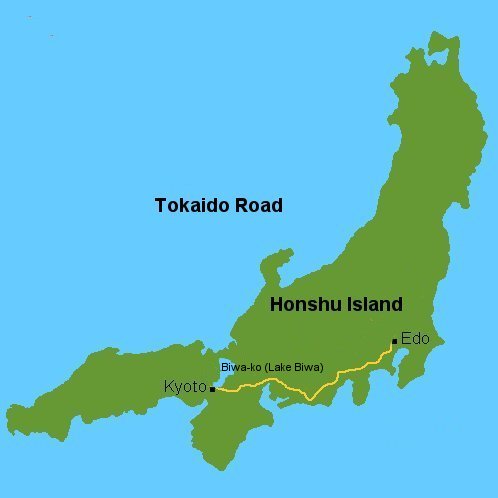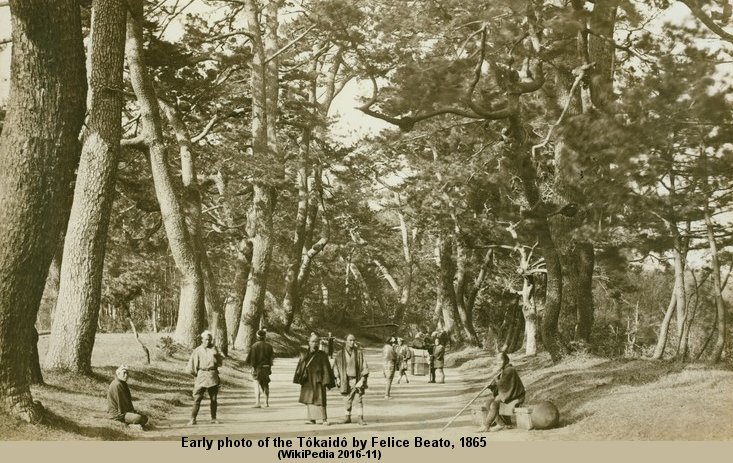| |
HIROSHIGE
|
|
The Tōkaidō (東海道 - literally, the 'Eastern Sea Road') was the main road of feudal Japan. It ran for roughly five hundred kilometers between the old imperial capital, Kyōto, where the Emperor still lived, and Edo (nowadays Tokiyo), home of the Shōgun as de facto military ruler.
The Tōkaidō ran more or less along the coast, across the mountains, and around the southern end of Lake Biwa.
Fifty-three stations (not counting the two termini), which became post-towns (shuku-eki) over time, were established along it; they consisted of horse and porter stations, along with a range of lodging, food, etc, establishments for the use of travellers. The horses were mainly for use by official messengers, but weary travellers could also hire horses, or kago (palanquins).
Checkpoints called seki were set up by the Tokugawa government, where guards stood watch, and turned back those who did not have the appropriate passes. Within Edo itself, each section of the city (machi) was closed off by wooden gates called kido, which were closed every night, and re-opened early in the morning. A traveller wishing to start the first stage, at the Nihon-bashi (literally "Japan Bridge") in the heart of Edo would have to wait until the kido at the bridge was opened.
Additional barriers to travel were the larger rivers, which were generally unbridged (in part as a deliberate measure of the government, to slow down the movement of any large rebellious army, should one be formed). When the river was deep, travellers had to cross in boats, or be carried in kago, or on the back of a porter. After a heavy rain, crossings might be halted for several days, forcing all to wait for the waters to subside.
As follow-ups to the successful series of the first "Tokaido", HIROSHIGE produced much more series (woodblock prints showing kites are marked):
- Hoeido Edition (1831-4), published by Takenouchi Magohachi
("Hoeido"); this series proved so popular that Kunisada
produced a Tokaido series featuring figures in front of a
landscape background virtually identical to these HIROSHIGE
prints (Station
27 Kakegawa)
- Kyoka
Edition (Late 1830s), Tokaido gojusan-tsugi - 56 prints
in chuban size, published ca. 1840 - also known as the Kyoka
Tokaido (from the kyoka verses on each print); pubished by Sanoki in Chuban
yokoye format
- Gyosho Edition (1841-2), Tokaido gojusan-tsugi no uchi -
55 prints in aiban size, published ca. 1841-42 - also known as the Gyosho
Tokaido. Gyosho in Japanese means an informal, more
scribbling-like type of characters, which was used for
the cartouches of this series; published by Yezakiya (Yetatsu),
2nd edition published by Yamadaya, both editions in
Aiban yokoye format. (Station
28 Fukuroi)
- Pairs Edition (Mid
1840s), Tokaido Gojusan Tsugi Hodogaya, published by
Ibasen, Ibakiu and others in Oban tataye format (no
woodblocks with kites)
- Aritaya Edition
(1844-8), Tokaido Gojusan Tsugi, published by
Aritaya (no woodblocks with kites)
- Reisho Edition (ca.1850), Reisho Tokaido - 55 prints in oban size, published ca. 1848-49; "Reisho" (Reissho") is the formal type of characters used for the cartouches of this series; Tokaido Gojusan Tsugi, published by Marusei in Oban yokoye format (Station 28 Fukuroi)
- Kichizo Edition (ca.1850), Tokaido Gojusan Tsugi, published by Tsutaya Kichizo in Chuban format (no woodblocks with kites)
- Tokaido gojusan-tsugi - 54 prints in chuban size, published ca. 1850 by Tsuta-ya (no woodblocks with kites)
- Jimbutsu Edition (1852), Tokaido Gojusan Tsugi, published by Muraichi in chuban tateye format (Station 28 Fukuroi)
- Fujikei Edition (1852), Tokaido Goju San Zuye, published by Fujikei in oban yokoye format (no woodblocks with kites)
- Tate-e
Edition (1855, The Vertical Tokaido) Tokaido
Gojusan Tsugi Meisho Dzuye, published by Tsutaya
in oban tateye format; known as the 'vertical'
or 'tate-e' Tokaido from the portrait (vertical)
orientation of the prints. (Station
28 Fukuroi)
- Tokaido by Two Brushes (1857), So-hitsu gojusan-tsugi - 55 vertical prints in oban size, published ca. 1854-57. This series was made in cooperation with Kunisada. The title means The "Fifty-three Stations from Two Brushes"; published by Maruya Kishiro in oban tateye format; in these prints the upper part consists of a Tokaido view by HIROSHIGE and in the lower part there are large figures by KUNISADA illustrative of legends. (no woodblocks with kites)
- Gojusan-tsugi meisho-zue - 55 prints in oban size, published in 1855 by Tsutaya (no woodblocks with kites)
- Tokaido Harimaze
Zuye, published
by Ibasen in oban tate-e format (no woodblocks with kites)
- Tokaido gojusan-tsugi - 62 prints in oban size, published in 1855. This series was a cooperation of three artists: HIROSHIGE, KUNISADA and KUNIYOSHI (no woodblocks with kites)
- Intermediate Stations and Views of the Narita Highway, Tokaido Yokyo Narita Dochu; drawn 1834-5 published 1919 by S. Sakai; drawings for the block made by Hiroshige which for some unknown reason were never used and were in the original condition as prepared for the engraver connected with the publisher Hoeido, or Takeuchi. (no woodblocks with kites)
- 'Shunga' Tokaido Series (no woodblocks with kites)
- Tokaido Fukei Zuye, published by Kinshodo as illustrated book (manga) in four volumes (no woodblocks with kites)
- Kichizo Tokaido,
published by Kichizo as illustrated book (manga) (no woodblocks with kites)
Other famous series produced by Utagawa Hiroshige are:
- "Famous Places of Kyoto" (no woodblocks with kites)
- "Famous Places in the Sixty-Odd Provinces" (no woodblocks with kites)
- "Sixty-nine Stations of the Kiso Kaido" (Kiso Highway) (no woodblocks with kites)
- "Eight Views of Biwa-ko" (Lake Biwa) (no woodblocks with kites)
- "Thirty-Six Views of Fuji-san" (Mount Fuji) (no woodblocks with kites in both editions of 1852 and 1858)
- "Famous Restaurants from the Eastern Capital" (no woodblocks with kites)
There are about 20 different editions with views of Edo. Some
of the contain woodblock print with kites
- "One Hundred Famous Views of Edo" (Meisho Edo Hyakkei) are considered to be as one of his greatest masterpieces (Prints Nr.2, Nr. 3,and Nr.21)
- Eight Views of the Eastern Capital (no woodblocks with kites)
- Famous Views of the Eastern Capital (no woodblocks with kites)
- Twelve Views of Edo (no woodblocks with kites)
- Famous Views of the Eastern Capital ((Toto Meisho,
東都名所 or Etsu Mesho, 江都名所) ; several sub-editions
with kites in Nr.4 and
Nr.24)
- Famous Views of Edo in the Four Seasons (no woodblocks with kites)
- Famous Views of Edo (no woodblocks with kites)
- Famous Places in Edo (Edo meisho, 江戸名所) (Outside
Hibiya and Bishamonten
Messenger Visiting Mount Atago)
- Eight Views in the Neighbourhood of Edo (no woodblocks with kites)
- A Grand Series of Famous Restaurants in Edo (no woodblocks with kites)
- Eight Views of Edo (no woodblocks with kites)
- Famous Places in Edo and Murasaki's Genji (no woodblocks with kites)
- Eight Views of the Sumida River in Edo (no woodblocks with kites)
- A New Selection of Famous Places of Edo (no woodblocks with kites)
- Five Elements in Famous Places of Edo (no woodblocks with kites)
- Twelve Snows Scenes of the Eastern Capital (no woodblocks with kites)
- Eight Snow Scenes of the Eastern Metropolis (no woodblocks with kites)
- Annual Events and Sights of Interest in Edo (no woodblocks with kites)
- Miscellaneous Views of Edo (no woodblocks with kites)
- Famous Sites of Edo (no woodblocks with kites)
- Famous Views of Edo (no woodblocks
with kites)
and miscellaneous other series...

Copyright 2008 ff: Hans P. Boehme
